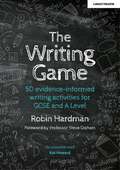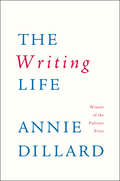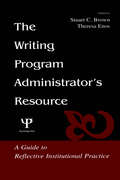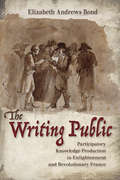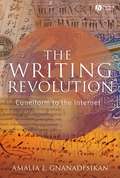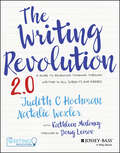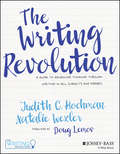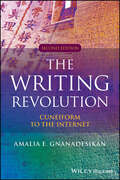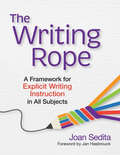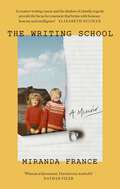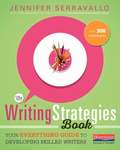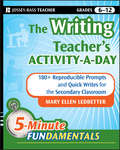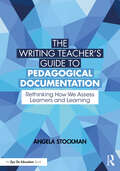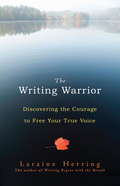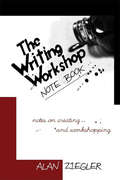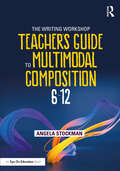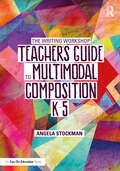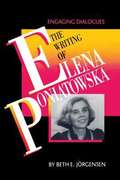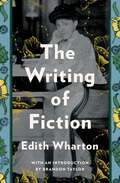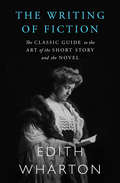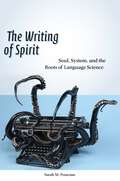- Table View
- List View
The Writing Game: 50 Evidence-Informed Writing Activities for GCSE and A Level
by Robin HardmanAs every humanities or social science teacher knows, success in exam years relies on pupils’ ability to blend subject knowledge with writing skills. But teachers face two significant problems in developing writing in their classroom: many pupils regard writing practice as a chore or a punishment; and research on writing instruction remains difficult for busy teachers to access. The Writing Game: 50 Evidence-Informed Writing Activities for GCSE and A Level aims to solve these problems by providing a must-read practical toolkit for teachers looking to help their pupils to write their way into the top grades, offering a menu of engaging lesson activities that can be modified to suit any subject context. With activities covering modelling, practice, and feedback, The Writing Game supports teachers to deliver research-informed strategies at every stage of the learning process. Perfect for teachers, middle leaders, and senior leaders, The Writing Game also contains tips on how to incorporate writing practice into regular subject content, formative assessment, and retrieval practice. Each activity is fully explained and accompanied by top tips for maximising effective learning, suggested adaptations, and links to appropriate research. Activities range from rapid five-minute starters and plenaries to whole-lesson extended writing tasks, with plenty in between, and busy teachers will be relieved to hear that many require very little preparation.
The Writing Game: 50 Evidence-Informed Writing Activities for GCSE and A Level
by Robin HardmanAs every humanities or social science teacher knows, success in exam years relies on pupils’ ability to blend subject knowledge with writing skills. But teachers face two significant problems in developing writing in their classroom: many pupils regard writing practice as a chore or a punishment; and research on writing instruction remains difficult for busy teachers to access. The Writing Game: 50 Evidence-Informed Writing Activities for GCSE and A Level aims to solve these problems by providing a must-read practical toolkit for teachers looking to help their pupils to write their way into the top grades, offering a menu of engaging lesson activities that can be modified to suit any subject context. With activities covering modelling, practice, and feedback, The Writing Game supports teachers to deliver research-informed strategies at every stage of the learning process. Perfect for teachers, middle leaders, and senior leaders, The Writing Game also contains tips on how to incorporate writing practice into regular subject content, formative assessment, and retrieval practice. Each activity is fully explained and accompanied by top tips for maximising effective learning, suggested adaptations, and links to appropriate research. Activities range from rapid five-minute starters and plenaries to whole-lesson extended writing tasks, with plenty in between, and busy teachers will be relieved to hear that many require very little preparation.
The Writing Life
by Annie DillardAnnie Dillard has written eleven books, including the memoir of her parents, An American Childhood; the Northwest pioneer epic The Living; and the nonfiction narrative Pilgrim at Tinker Creek. A gregarious recluse, she is a member of the American Academy of Arts and Letters.
The Writing Program Administrator's Resource: A Guide To Reflective Institutional Practice
by Stuart C. Brown Theresa Enos Catherine ChaputThe role of the writing program administrator is one of diverse activities and challenges, and preparation for the position has traditionally come through performing the job itself. As a result, uninitiated WPAs often find themselves struggling to manage the various requirements and demands of the position, and even experienced WPAs often encounter situations on which they need advice. The Writing Program Administrator's Resource has been developed to address the needs of all WPAs, regardless of background or experience. It provides practical, applicable tools to effectively address the differing and sometimes competing roles in which WPAs find themselves. Readers will find an invaluable collection of articles in this volume, addressing fundamental practices and issues encountered by WPAs in their workplace settings and focusing on the hows and whys of writing program administration. With formal preparation and training only now beginning to catch up to the very real needs of the WPA, this volume offers guidance and support from authoritative and experienced sources--educators who have established the definitions and standards of the position; who have run into obstacles and surmounted them; and who have not just survived but thrived in their roles as WPAs. Editors Stuart C. Brown and Theresa Enos contribute their own experience and bring together the voices of their colleagues to delineate the intellectual scope and practices of writing program administration as an emerging discipline. Established and esteemed leaders in the field offer insights, advice, and plans of action for the myriad scenarios encountered in the position, encouraging WPAs and helping them to realize that they often know more than they think they do. This resource is required reading for the new WPA, and an essential reference for all who serve in the WPA role. As a guidebook for WPAs, it is destined to become a fixture on the desk of every educator involved with or interested in administrating writing programs, writing centers, and writing-across-the-curriculum efforts.
The Writing Public: Participatory Knowledge Production in Enlightenment and Revolutionary France
by Elizabeth Andrews BondInspired by the reading and writing habits of citizens leading up to the French Revolution, The Writing Public is a compelling addition to the long-running debate about the link between the Enlightenment and the political struggle that followed. Elizabeth Andrews Bond scoured France's local newspapers spanning the two decades prior to the Revolution as well as its first three years, shining a light on the letters to the editor. A form of early social media, these letters constituted a lively and ongoing conversation among readers.Bond takes us beyond the glamorous salons of the intelligentsia into the everyday worlds of the craftsmen, clergy, farmers, and women who composed these letters. As a result, we get a fascinating glimpse into who participated in public discourse, what they most wanted to discuss, and how they shaped a climate of opinion. The Writing Public offers a novel examination of how French citizens used the information press to form norms of civic discourse and shape the experience of revolution. The result is a nuanced analysis of knowledge production during the Enlightenment.Thanks to generous funding from Michigan State University and its participation in TOME (Toward an Open Monograph Ecosystem), the ebook editions of this book are available as Open Access (OA) volumes, available on the Cornell University Press website and other Open Access repositories.
The Writing Revolution
by Amalia E. GnanadesikanIn a world of rapid technological advancements, it can be easy to forget that writing is the original Information Technology, created to transcend the limitations of human memory and to defy time and space. The Writing Revolution picks apart the development of this communication tool to show how it has conquered the world.Explores how writing has liberated the world, making possible everything from complex bureaucracy, literature, and science, to instruction manuals and love lettersDraws on an engaging range of examples, from the first cuneiform clay tablet, Egyptian hieroglyphs, and Japanese syllabaries, to the printing press and the text messagingWeaves together ideas from a number of fields, including history, cultural studies and archaeology, as well as linguistics and literature, to create an interdisciplinary volumeTraces the origins of each of the world's major written traditions, along with their applications, adaptations, and cultural influences
The Writing Revolution 2.0: A Guide to Advancing Thinking Through Writing in All Subjects and Grades
by Natalie Wexler Judith C. HochmanLead a writing revolution in your classroom with the proven Hochman Method Building on the success of the original best-seller, this new edition of The Writing Revolution adds valuable guidance for teachers seeking a way to bring their students' writing ability up to rigorous state standards. As thousands of educators have already discovered, The Writing Revolution provides the road map they need, clearly explaining how to incorporate the Hochman Method into their instruction, no matter what subject or grade they're teaching and regardless of the ability level of their students. The new edition provides a reorganized sequence of activities and even more student-facing examples, making it easier than ever to bring the method to your classroom. The Writing Revolution isn't a separate curriculum or program teachers need to juggle. Rather, it is a method providing strategies and activities that teachers can adapt to their preexisting curriculum and weave into their content instruction. By focusing on specific techniques that match their students' needs and providing them with targeted feedback, The Writing Revolution can turn weak writers into strong and confident communicators. In addition, the method can: Identify misconceptions and gaps in knowledge Boost reading comprehension and learning Improve organizational skills Enrich oral language Develop analytical abilities The Writing Revolution takes the mystery out of teaching students to write well.
The Writing Revolution: A Guide to Advancing Thinking Through Writing in All Subjects and Grades
by Natalie Wexler Judith C. Hochman"HELP! My Students Can't Write!" Why You Need a Writing Revolution in Your Classroom and How to Lead It. The Writing Revolution (TWR) provides a clear method of instruction that you can use no matter what subject or grade level you teach. The model, also known as The Hochman Method, has demonstrated, over and over, that it can turn weak writers into strong communicators by focusing on specific techniques that match their needs and by providing them with targeted feedback. Insurmountable as the challenges faced by many students may seem, TWR can make a dramatic difference. And the method does more than improve writing skills. It also helps: Boost reading comprehension Improve organizational and study skills Enhance speaking abilities Develop analytical capabilities TWR is as much a method of teaching content as it is a method of teaching writing. There's no separate writing block and no separate writing curriculum. Instead, teachers of all subjects adapt the TWR strategies and activities to their current curriculum and weave them into their content instruction. But perhaps what's most revolutionary about the TWR method is that it takes the mystery out of learning to write well. It breaks the writing process down into manageable chunks and then has students practice the chunks they need, repeatedly, while also learning content.
The Writing Revolution: Cuneiform to the Internet (The Language Library #25)
by Amalia E. GnanadesikanIn a world of rapid technological advancements, it can be easy to forget that writing is the original Information Technology, created to transcend the limitations of human memory and to defy time and space. The Writing Revolution picks apart the development of this communication tool to show how it has conquered the world. Explores how writing has liberated the world, making possible everything from complex bureaucracy, literature, and science, to instruction manuals and love letters Draws on an engaging range of examples, from the first cuneiform clay tablet, Egyptian hieroglyphs, and Japanese syllabaries, to the printing press and the text messaging Weaves together ideas from a number of fields, including history, cultural studies and archaeology, as well as linguistics and literature, to create an interdisciplinary volume Traces the origins of each of the world’s major written traditions, along with their applications, adaptations, and cultural influences
The Writing Revolution: Cuneiform to the Internet (The Language Library)
by Amalia E. GnanadesikanNow in its second edition, The Writing Revolution takes readers on a journey through the origins, historical development, adaptations, linguistic properties, cultural context, and social impact of the world’s major written traditions. Demonstrating how the creation of writing transcended the limitations of human memory and made the modern world possible, linguist Amalia E. Gnanadesikan offers an engaging, easy-to-read historical narrative of written language that covers everything from the earliest proto-cuneiform tablet to the latest AI-generated text. Concise chapters describe how different writing systems originated, how they evolved over time, and how they represent the thoughts and sounds expressed in spoken language. Throughout the book, Gnanadesikan interweaves ideas from cultural studies, archaeology, linguistics, literature, anthropology, and information science—complemented by illustrative examples of Egyptian hieroglyphs, Japanese syllabaries, Chinese characters, New World writing systems, the Roman alphabet, and many others. Featuring new and expanded coverage of the Digital Age, including Unicode, the internet, emojis, and generative AI, The Writing Revolution: Cuneiform to the Internet is essential reading for students of writing systems, linguistics, information science, and intellectual history, as well as general readers with an interest in the remarkable history of written language.
The Writing Rope: A Framework for Explicit Writing Instruction in All Subjects
by Jan Hasbrouck Joan SeditaWriting is a task as complex and multifaceted as reading—but it’s often taught as a single skill. Discover how to plan and deliver comprehensive, explicit, and evidence-based writing instruction with this groundbreaking book, aligned with IDA’s Structured Literacy approach and based on the latest research. <p><p> Joan Sedita's innovative Writing Rope weaves multiple skills and strategies into five fundamentals of a comprehensive writing curriculum: critical thinking, syntax (sentences), text structure, writing craft, and transcription (spelling and handwriting). Teachers of Grades 4-8 will get crystal-clear guidelines that demystify the process of helping students learn to write and write to learn across academic content areas. And with dozens of included templates, handouts, and other resources—available for download online—teachers will have all the tools they need to design and deliver explicit, high-quality writing instruction. <p><p> Perfect for professional development, this invaluable planning guide will help teachers apply the science of reading to the skill of writing—and help students master a critically important aspect of literacy.
The Writing School
by Miranda France'Both extremely funny and deeply sad, The Writing School examines how and why we tell our own stories. It's beautifully written and structured, compelling, wise and fabulously readable' Lissa Evans'The Writing School is an extraordinary book. It is funny, exhilarating, heart-breaking and passionate. Its delicate pulsing themes are held like a bird in the writer's confident, gentle hand' Katharine Norbury'Life, with its unexpected troughs and highs, the disciplines of teaching a creative writing course and the shadow of a family tragedy provide the focus for a memoir that brims with humour, honesty and intelligence. The Writing School taught me a lot' Elizabeth BuchanA creative writing course is a chance for reinvention. When author Miranda France sets off to teach at a residential writing school in a remote valley, she expects to meet a group of aspiring writers with the usual mix of hope and unrealised ambitions, talents and motivation.Tensions are bound to emerge over the course of the week they spend together: personalities will clash, egos will need to be tamed or gently encouraged. What France doesn't expect, as she takes her tutees through a series of exercises designed to help them explore different aspects of their writing, is that a ghost from her own life will join them.As the daily drama of the writing school unfurls, so memories resurface concerning a death that profoundly shaped the author's world when she was a teenager. Soon France's memories interweave with her present task of thinking about writing and storytelling, and she too becomes a student: asking, what is to be done with our memories of those we have lost? What is behind the urge to put lives into words? And is it ever right to tell another person's story?A delightful and unusual blend of storytelling and memoir, packed full of literary anecdote and insight from the author's own experience as well as that of other writers and poets, The Writing School is a moving and often very funny book about why people write, as well as being a uniquely generous masterclass on the art of writing itself.
The Writing Strategies Book: Your Everything Guide to Developing Skilled Writers
by Jennifer SerravalloStudents' needs to high-quality instruction is made simpler with 300 strategies.
The Writing Teacher's Lesson-a-Day: 180 Reproducible Prompts and Quick-Writes for the Secondary Classroom (JB-Ed: 5 Minute FUNdamentals #3)
by Mary Ellen LedbetterClassroom-tested methods for boosting secondary students' writing skills The Writing Teacher's Activity-a-Day offers teachers, homeschoolers, and parents 180 ready-to-use, reproducible activities that enhance writing skills in secondary students. Based on Ledbetter's extensive experience consulting to language arts teachers and school districts across the country, the classroom-tested activities included in this book teach students key literary and writing terms like allegory, elaboration, irony, personification, propaganda, voice, and more--and provide them with engaging examples that serve as models for their own Quick Writes. Contains writing prompts and sample passages in student-friendly language that connects abstract literary concepts to students' own lives Written by popular workshop presenter and veteran educator Mary Ellen Ledbetter Offers a user-friendly, value-packed resource for teaching writing skills Designed for English language arts teachers in grades 6-12, tutors, parents, learning specialists, homeschoolers, and consultants.
The Writing Teacher’s Guide to Pedagogical Documentation: Rethinking How We Assess Learners and Learning
by Angela StockmanThis book is a call to action for English and English Language Arts teachers who understand that data are not numbers alone, learning is impossible to quantify, and students are our very best teachers. Writing teacher Angela Stockman shows us how pedagogical documentation—the practice of making learning visible, capturing what is seen and heard, and then interpreting those findings in the company of our students and our colleagues—is a humbling and humane practice that grounds what we think we’ve come to know in the lived experiences of those we intend to serve. In this rich resource, she offers: processes and protocols for documenting learning and analyzing data; resources and planning tools to help you design and execute your own projects; and a digital documentation notebook that you can download for guidance, inspiration, and examples. With the powerful tools in this book, you’ll be inspired to reach students whose needs have been ignored by big data and whose identities have been erased by oppressive forms of assessment and evaluation.
The Writing Teacher’s Guide to Pedagogical Documentation: Rethinking How We Assess Learners and Learning
by Angela StockmanThis book is a call to action for English and English Language Arts teachers who understand that data are not numbers alone, learning is impossible to quantify, and students are our very best teachers.Writing teacher Angela Stockman shows us how pedagogical documentation—the practice of making learning visible, capturing what is seen and heard, and then interpreting those findings in the company of our students and our colleagues—is a humbling and humane practice that grounds what we think we’ve come to know in the lived experiences of those we intend to serve. In this rich resource, she offers: processes and protocols for documenting learning and analyzing data; resources and planning tools to help you design and execute your own projects; and a digital documentation notebook that you can download for guidance, inspiration, and examples With the powerful tools in this book, you’ll be inspired to reach students whose needs have been ignored by big data and whose identities have been erased by oppressive forms of assessment and evaluation.
The Writing Warrior: Discovering the Courage to Free Your True Voice
by Laraine HerringAll writers are faced at some point with feelings of self-consciousness and self-doubt about their work. In this invaluable guide, Laraine Herring offers advice to writers who want to become more comfortable with their writing, face their inhibitions, and gain the confidence to release their true voice. Utilizing the breath, a vigorous movement practice designed to break up stagnation with the body and the mind, and writing exercises aimed both at self-exploration and developing works-in-progress, Herring offers a clear path to writing through illusion. Learn how to remove obstacles in your writing and develop techniques to help you relax into your own voice; discover ways to enter into a compassionate, non-judgmental relationship with yourself so that you can write safely and authentically from a place of absolute vulnerability; and discover the interconnectedness of your personal writing process and the community as a whole. The Writing Warrior will not only help you find ways to develop your writing, but also ways to develop yourself.To learn more about the author, visit her website at www.laraineherring.com.
The Writing Workshop Note Book: Notes on Creating and Workshopping
by Alan ZieglerThe Writing Workshop Notebook is devoted to making, remaking, and remarking on writing. Ziegler's text is animated by a concern about how we relate to our own and others’ writing and by a desire to have a suitable effect on the reader’s experience with writing and critiquing. The book is supported by the author's experience from decades of leading writing workshops.
The Writing Workshop Teacher's Guide to Multimodal Composition (6-12)
by Angela StockmanMultimodal composition is a meaningful and critical way for students to tell their stories, make good arguments, and share their expertise in today’s world. In this helpful resource, writer, teacher, and best-selling author Angela Stockman illustrates the importance of making writing a multimodal endeavor in 6-12 workshops by providing peeks into the classrooms she teaches within. Chapters address what multimodal composition is, how to situate it in a writing workshop that is responsive to the unique needs of writers, how to handle curriculum design and assessment, and how to plan instruction. The appendices offer tangible tools and resources that will help you implement and sustain this work in your own classroom. Ideal for teachers of grades 6-12, literacy coaches, and curriculum leaders, this book will help you and your students reimagine what a workshop can be when the writers within it produce far more than written words.
The Writing Workshop Teacher’s Guide to Multimodal Composition (K-5)
by Angela StockmanMultimodal composition is a meaningful and critical way for students to tell their stories, make good arguments, and share their expertise in today’s world. In this helpful resource, writer, teacher, and best-selling author Angela Stockman illustrates the importance of making writing a multimodal endeavor in K-5 workshops by providing peeks into the classrooms she teaches within. Chapters address what multimodal composition is, how to situate it in a writing workshop that is responsive to the unique needs of writers, how to handle curriculum design and assessment, and how to plan instruction. The appendices offer tangible tools and resources that will help you implement and sustain this work in your own classroom. Ideal for teachers of grades K-5, literacy coaches, and curriculum leaders, this book will help you and your students reimagine what a workshop can be when the writers within it produce far more than written words.
The Writing of Elena Poniatowska: Engaging Dialogues
by Beth E. JörgensenElena Poniatowska is one of Latin America's most distinguished and innovative living writers. Advocacy of women and the poor in their struggle for social and economic justice, denunciation of the repression of that struggle, and a tendency to blur the boundaries between conventional literary forms characterize her writing practice.
The Writing of Fiction: The Classic Guide To The Art Of The Short Story And The Novel (The\collected Works Of Edith Wharton)
by Edith WhartonA rare work of nonfiction from Edith Wharton, The Writing of Fiction contains brilliant advice on writing from the first woman ever to win a Pulitzer Prize -- for her first novel The Age of Innocence. In The Writing of Fiction, Wharton provides general comments on the roots of modern fiction, the various approaches to writing a piece of fiction, and the development of form and style. She also devotes entire chapters to the telling of a short story, the construction of a novel, and the importance of character and situation in the novel. Not only a valuable treatise on the art of writing, The Writing of Fiction also allows readers to experience the inimitable but seldom heard voice of one of America's most important and beloved writers, and includes a final chapter on the pros and cons of Marcel Proust.
The Writing of Fiction: The Classic Guide to the Art of the Short Story and the Novel (The\collected Works Of Edith Wharton)
by Edith WhartonEssays on the craft of fiction writing from the first woman to win the Pulitzer Prize, for her novel The Age of Innocence.In The Writing of Fiction,Edith Wharton, a prolific writer and one of the twentieth century&’s greatest authors, shares her thoughts on fiction writing, devoting individual chapters to short stories and novels. She stresses the importance of writers putting thought into how they build their story, from selecting subject matter and fashioning characters to crafting situations and settings. She explores the history of modern fiction and the contributions of Honoré de Balzac and Stendhal. She even examines the difference between literary and commercial fiction, as well as the work of Marcel Proust.Although Wharton passed away in 1937, her advice here endures and is bound to inspire writers for ages to come. &“In The Writing of Fiction Edith Wharton gives us not only a period-appropriate glimpse into the mind of an exceptionally creative writer but also an appreciation for the thoughtfulness and discipline she brought to her craft. We are fortunate she was willing to share her observations.&” —Ralph White, author of Litchfield
The Writing of Modern Fiction
by Robert SomerlottThe author, a novelist and short-story writer with extensive experience teaching creative writing, gathers suggestions for beginning fiction writers. He discusses character, plot, suspense, the use of detail, and more. Many examples are drawn from the author's own work and experience, and from the works of other writers including Flannery O'Connor, John Steinbeck, and William Maxwell.
The Writing of Spirit: Soul, System, and the Roots of Language Science
by Sarah M. PourciauContemporary thought has been profoundly shaped by the early-twentieth-century turn toward synchronic models of explanation, which analyze phenomena as they appear at a single moment, rather than diachronically as they develop through time. But the relationship between time and system remains unexplained by the standard account of this shift. Through a new history of systematic thinking across the humanities and sciences, The Writing of Spirit argues that nineteenth-century historicism wasn’t simply replaced by a more modern synchronic perspective. The structuralist revolution consisted rather in a turn toward time’s absolutely minimal conditions, and thus also toward a new theory of diachrony.Pourciau arrives at this surprising and powerful conclusion through an analysis of language-scientific theories over the course of two centuries, associated with thinkers from Jacob Grimm and Richard Wagner to the Russian Futurists, in domains as disparate as historical linguistics, phonology, acoustics, opera theory, philosophy, poetics, and psychology. The result is a novel contribution to a pressing contemporary question—namely, what role history should play in the interpretation of the present.
